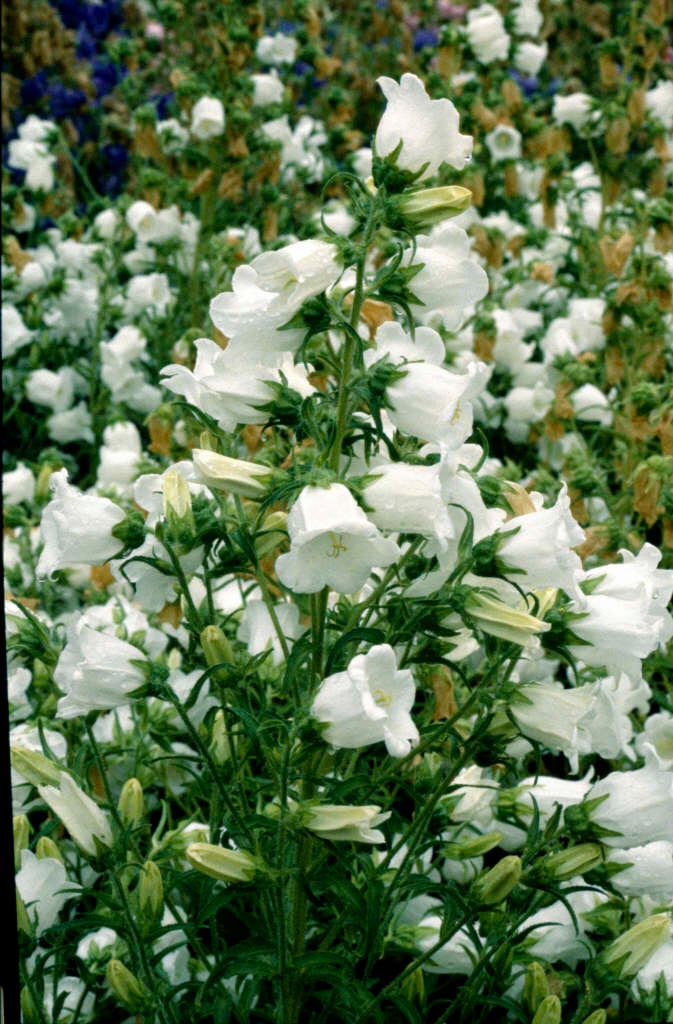Campanula medium The RHS Award of Garden Merit (AGM) helps gardeners choose the best plants for their garden. RHS Plants for Pollinators plantsThis plant will provide nectar and pollen for bees and the many other types of pollinating is included in an evolving list of plants carefully researched and chosen by RHS experts. Divided into 3 groups these lists, linked below, are maintained by a team of RHS staff and are reviewed n PlantsWildflowersPlants of the World
USES
Growing and Saving the Seed of Canterbury Bells
Latin name Campanula medium is typically a biennial (sometimes will bloom in the first year) flower native to southern Europe. Hardy from USDA zones 4-8. In the first year the plants will produce a short rosette of foliage, with no flowers. They will bloom in their second year of growth.
HISTORY
Native to southern Europe, this plant is naturalized across Europe and in parts of North America as well. A popular cottage garden choice, the bells are shaped like little drinking glasses and make a superb cut flower. In the language of flowers, Canterbury Bells signify gratitude.
USES
- Ornamental
- Landscaping, beds, borders, cottage garden, cut flower garden

- Seeds germinate in 14-21 days.
- Surface sow seeds and very lightly press them into the soil or cover with a super thin layer of vermiculite or fine potting soil, as the seeds require light in order to germinate.
- Start seeds indoors in spring or directly sow them in the garden.
- Ideal germination temperature is 72-75 F.
- Do not allow seeds to dry out until germinated.

- Campanula prefers rich, well-drained soil and full sun to part shade.
- This European native likes temperate conditions, so if you live in a very hot summer location, plant in a location with afternoon shade.
- Space plants 10 inches apart.
- Plants should be dead-headed.
PESTS/SPECIAL CONSIDERATIONS
Typically pest-free, Canterbury Bells will reach up to 3 feet tall in their second year and may require staking to support their long, slender stalks.

Seed saving is easy: simply allow blooms to fade on the plant and collect the dried seeds. You can sow these seeds in late summer, allowing them to stratify over winter.
Canterbury bells
A biennial of upright growth, with a basal rosette of lance-shaped leaves to 15cm long and a leafy stem bearing broadly bell-shaped, blue, pink or white, single or double flowers in summer
Other common names
Canterbury bell
Coventry bells
see more Coventry rapes
cup and saucer
fair-in-sight
gingerbread bells
mariettes
Mercury’s violets
St Thomas’s bell
lady’s nightcap
Synonyms
Join the RHS today and save 30%

Buy this plant
Size
Ultimate height
Time to ultimate height
Ultimate spread
Growing conditions
Moisture
pH
Colour and scent
| Stem | Flower | Foliage | Fruit |
| Spring | Green | ||
|---|---|---|---|
| Summer | Blue Pink White | Green | |
| Autumn | |||
| Winter |
Position
Aspect
West–facing or East–facing or South–facing
Exposure
Hardiness
Hardiness ratings
All ratings refer to the UK growing conditions unless otherwise stated. Minimum temperature ranges (in degrees C) are shown in brackets
- H1a: under glass all year (>15C)
- H1b: can be grown outside in the summer (10 – 15)
- H1c: can be grown outside in the summer (5 – 10)
- H2: tolerant of low temperatures, but not surviving being frozen (1 to 5)
- H3: hardy in coastal and relatively mild parts of the UK (-5 to 1)
- H4: hardy through most of the UK (-10 to -5)
- H5: hardy in most places throughout the UK even in severe winters (-15 to -10)
- H6: hardy in all of UK and northern Europe (-20 to -15)
- H7: hardy in the severest European continental climates ( < -20)
Botanical details
Family Campanulaceae Native to the UK No Foliage Deciduous Habit Bushy Genus
Campanula may be annuals, herbaceous or evergreen perennials, with bell or star-shaped, often blue, flowers in late spring or summer
Plant range S Europe
How to grow
Cultivation
It prefers fertile, moist but well-drained soil. It will tolerate wide range of soil types if well-drained. Grow in sun or partial shade. Suitable for container cultivation
Propagation
Propagate by seed. Surface sow seeds from late spring to early summer. In milder areas sow directly in the autumn
Suggested planting locations and garden types
- Patio and container plants
- Cottage and informal garden
- Flower borders and beds
- Underplanting of roses and shrubs
Pruning
Do not cut back after flowering if self-seeding is desired. However, removing of the spent flower spikes may encourage second flush of flowers
Pests
Vulnerable to slugs and snails